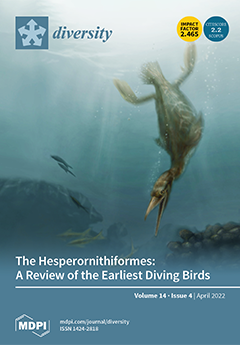A marine
Alphaproteobacterium designated as strain NZ-96
T was isolated in February 2021, from a sponge species (
Demospongiae) collected in muddy sediments with boulders and old chimneys in Otago/Canterbury Slope, Pacific Ocean, New Zealand. The isolate was found to be Gram-negative,
[...] Read more.
A marine
Alphaproteobacterium designated as strain NZ-96
T was isolated in February 2021, from a sponge species (
Demospongiae) collected in muddy sediments with boulders and old chimneys in Otago/Canterbury Slope, Pacific Ocean, New Zealand. The isolate was found to be Gram-negative, rod-shaped, aerobic, motile, and produced yellow-colored colonies. The isolate was positive for alkaline phosphatase, leucine arylamidase, trypsin, catalase, and oxidase and negative for α-galactosidase and urease. It was resistant to many antibiotics including hygromycin, trimethoprim, spectinomycin, ampicillin, oxytetracycline, cephalosporin, bacitracin, and polymyxin. The 16S rRNA gene-based phylogenetic analyses exhibited that strain NZ-96
T belonged to the genus
Qipengyuania and showed 98.3–98.8% 16S rRNA gene sequence similarity to its closest relatives. The major respiratory quinone was ubiquinone-10 (Q-10). The polar lipid profile consisted of phosphatidylcholine, sphingoglycolipid, phosphatidylglycerol, one unknown polar lipid, and three unknown glycolipids. The major fatty acids were C
18:1ω12t, C
16:0, C
16:1ω7c, C
17:1ω6c, C
16:02-OH, and C
14:0 2-OH. Carotenoid were produced. The crude extract showed pronounced activity against
Staphylococcus aureus Newman and
Bacillus subtilis DSM 10. Pairwise ANI and dDDH values of strain NZ-96
T and closely related phylogenetic hits were below the threshold values of 95% and 70%, respectively. Genes for trehalose biosynthesis, aspartate-semialdehyde dehydrogenase, flagellar biosynthesis, fatty acid biosynthesis, and antibiotics resistance were present, which aids in isolate survival in a sea or ocean environment. The DNA G+C content was 60.8% (by genome). Based on data obtained by the polyphasic approach, strain NZ-96
T (= DSM 112811
T = NCCB 100842
T) represents a novel species of the genus
Qipengyuania, for which the name
Qipengyuania pacifica sp. nov. is proposed.
Full article





